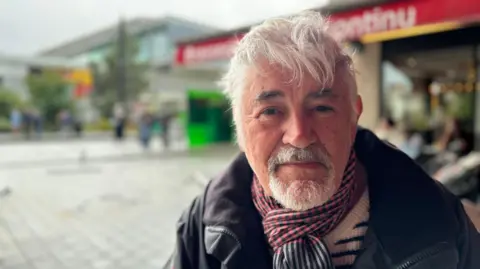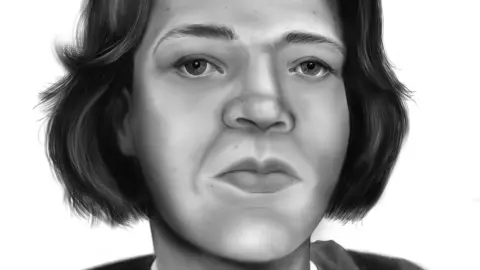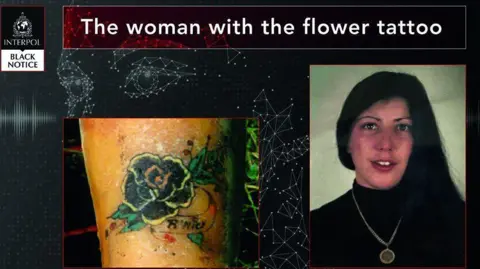Interpol is asking the public to help solve new cases of missing women

 Interpol
InterpolA pair of red shoes, two bead necklaces and a British 10p coin are among several clues that could help identify a girl found murdered in western France more than 40 years ago.
Her death is one of 46 cold cases European police are seeking to solve as part of the second phase of an operation aimed at finding the names of unidentified murdered women.
The BBC’s coverage of the appeal last year helped identify the British woman nearly 30 years after her murder.
“We want to identify the dead women, bring answers to the families, and bring justice to the victims,” said Jürgen Stock, the secretary general of Interpol, which is coordinating the effort, in a statement on Tuesday.
“Whether it’s a memory, a tip, or a shared story, small details can help reveal the truth.”
The second phase of the Operation Identify Me campaign includes cases in the Netherlands, Germany, Belgium, France, Italy and Spain.

Details of each are published on the Interpol website, along with photos of possible identifications and facial reconstructions.
Most of the victims are thought to be between the ages of 15 and 30.
The body of a young man with red shoes, bead necklaces and a 10p piece was found under layers of leaves in a village called Le Cellier in 1982. Then it has been there for a few months.
Speaking near the site where he was found, now overgrown with brambles, nettles and horse chestnut trees, coroner Franc Dannerolle said the teenager’s body was “discarded like rubbish”.
“There was no respect, no care for him before his death,” he adds.
The 10p coin led investigators to believe he was British or had visited Britain before his murder, although they admit he could have received it, or been given one.
The police have chosen not to disclose the details of his murder to avoid “fake criminals” claiming guilt.
Unfortunately, the teenager’s remains have never been found, making the work of cold case investigators difficult.
“If we can find them, we may be able to work on his DNA to make connections with the family,” Det Dannerolle said.

Retired detective Alain Brillet worked on the case at the time and describes it as a “triple mystery”.
“The strangest and most unbelievable thing is that we had a person who was killed because we knew that he was killed but we could not find out his name, where he is from or who killed him,” he said. .
The BBC found one woman who recalled the fear of her body being found in the village, but because the victim was not from the area, most people forgot and moved on.
 Interpol
InterpolThe launch of Operation Ngikhombe last year marked the first time that Interpol went public with a list known as “black notices”, seeking information on unidentified bodies. Such notices have historically been circulated only internally within the Interpol police network.
Across Europe, ease of travel due to open borders, increased global migration, and people-trafficking have led to more people being reported missing outside their country of origin, said Dr Susan Hitchin, Interpol’s DNA unit coordinator.
“These women faced repeated injustice. They have become victims twice: they were killed in an act of violence and their name was denied in death,” he said.
Interpol uses targeted social media to advertise the campaign in specific areas and demographics. The international police force has also been asking celebrities to speak up for the unknown, unnamed women.
Another case that Interpol hopes people can solve is that of a woman whose body was found in Wassenaar in the Netherlands twenty years ago.
The discovery was the first case of Dutch investigator Sandra Baasbank. He remembers seeing a woman lying face down in the sand dunes, with no obvious signs of injury or struggle.

Det Baasbank says the woman was wearing brown plaid leggings and shiny red patent shoes – “unusual if you’re going for a sea breeze”.
“He was healthy, athletic. Wearing a headband, and sunglasses. His buttons were off and he was wearing a scarf,” the detective added.
An investigative analysis found that the woman was born in Eastern Europe and spent the last five years of her life in Western Europe.
One of the keys he was carrying was traced back to Germany.
“Maybe you made me better at what I do. ‘Never give up,’ is my motto. I am determined in the work I do, and maybe you are the reason,” said Det Baasbank.
He hopes the new Identify Me campaign will help ignite new leads and provide some sort of closure.
And there is reason for hope.
 Interpol
InterpolRita Roberts, the British woman who was murdered in Belgium, was identified when her family saw her distinctive black rose tattoo in a BBC report based on an initial request.
His family’s last contact with him was by postcard in May 1992. His body was found the following month.
When her family was told that the body was indeed Rita’s, her sister Donna says she “broke tears”. For them, decades of uncertainty had ended.
Although it was difficult to read about her sister’s death, she says she is comforted by the fact that Rita is “at peace”.
Now that he has been identified, his family is asking the public for any information, no matter how small, to help with the investigation.
And they hope that other murdered women will be identified.
“They are sisters, mothers, aunts,” said Donna. “Just because they don’t have names, don’t think they aren’t human.”
Additional reporting by Léontine Gallois
Source link




